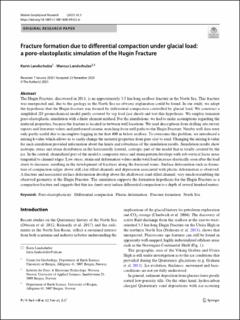| dc.contributor.author | Landschulze, Karin | |
| dc.contributor.author | Landschulze, Marcus | |
| dc.date.accessioned | 2021-08-03T10:03:26Z | |
| dc.date.available | 2021-08-03T10:03:26Z | |
| dc.date.created | 2021-02-17T10:18:33Z | |
| dc.date.issued | 2021 | |
| dc.identifier.issn | 0025-3235 | |
| dc.identifier.uri | https://hdl.handle.net/11250/2765984 | |
| dc.description.abstract | The Hugin Fracture, discovered in 2011, is an approximately 3.5 km long seafloor fracture in the North Sea. This fracture was unexpected and, due to the geology in the North Sea no obvious explanation could be found. In our study, we adopt the hypothesis that the Hugin fracture was formed by differential compaction controlled by glacial load. We construct a simplified 2D geomechanical model partly covered by top load (ice sheet) and test this hypothesis. We employ transient poro-elastoplastic simulation with a finite element method. For the simulations, we had to make assumptions regarding the material properties, because the fracture is located in-between well locations. We used descriptions from drilling site survey reports and literature values and performed seismic matching form well paths to the Hugin Fracture. Nearby well data were only partly useful due to incomplete logging in the first 400 m below seafloor. To overcome this problem, we introduced a mixing k-value which allows us to easily change the material properties from pure clay to sand. Changing the mixing k-value for each simulation provided information about the limits and robustness of the simulation results. Simulation results show isotropic stress and strain distribution in the horizontally layered, isotropic part of the model that is totally covered by the ice. In the central, channelized part of the model a composite stress and strain pattern develops with sub-vertical focus areas tangential to channel edges. Low stress, strain and deformation values under total load increase drastically soon after the load starts to decrease, resulting in the development of fractures along the focussed zones. Surface deformation such as formation of compaction ridges above stiff clay-filled channels and depression associated with plastic deformation is observed. A fracture and associated surface deformation develop above the shallowest sand-filled channel, very much resembling the observed geometry at the Hugin Fracture. The simulation supports the formation hypothesis for the Hugin Fracture as a compaction fracture and suggests that thin ice sheets may induce differential compaction to a depth of several hundred meters. | en_US |
| dc.language.iso | eng | en_US |
| dc.publisher | Springer | en_US |
| dc.rights | Navngivelse 4.0 Internasjonal | * |
| dc.rights.uri | http://creativecommons.org/licenses/by/4.0/deed.no | * |
| dc.title | Fracture formation due to differential compaction under glacial load: a poro-elastoplastic simulation of the Hugin Fracture | en_US |
| dc.type | Journal article | en_US |
| dc.type | Peer reviewed | en_US |
| dc.description.version | publishedVersion | en_US |
| dc.rights.holder | Copyright 2021 The Authors | en_US |
| dc.source.articlenumber | 1 | en_US |
| cristin.ispublished | true | |
| cristin.fulltext | original | |
| cristin.qualitycode | 1 | |
| dc.identifier.doi | 10.1007/s11001-020-09422-w | |
| dc.identifier.cristin | 1890732 | |
| dc.source.journal | Marine Geophysical Researches | en_US |
| dc.relation.project | Norges forskningsråd: 208191 | en_US |
| dc.identifier.citation | Marine Geophysical Researches. 2021, 42(1), 1 | en_US |
| dc.source.volume | 42 | en_US |
| dc.source.issue | 1 | en_US |

